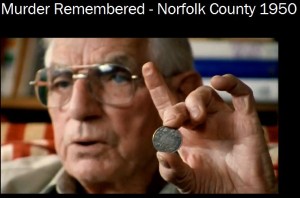*reprinted from the June 2014 edition of the Saint John Coin Club’s newsletter, Almost Circulated
This is a story, referred to me by Tom, about an early attempt to get rich counterfeiting the Canadian 50 cent piece by a criminal whose luck, execution and planning was to go from bad to worse very quickly.
Herbert McAuliffe showed promise growing up in North Bay, Ontario, doing well in school and showing some mechanical aptitude and in 1939 he enlisted in the army where he rose quickly to the rank of sergeant before, according to some accounts, being given a dishonourable discharge for stealing money from fellow soldiers. According to Max Haines’ book, Murder Most Foul, McAuliffe didn’t stop his thieving ways there – he walked away with nine guns, including a Thompson submachine gun.
He proceeded to set up shop in Windsor, Ontario in a rented garage, purchasing the equipment he needed to start his own personal mint – books, a lathe, punch presses and a hydraulic press. He funded this part of his operation by holding up service stations and grocery stores. It took him years, but his finished product, which he struck on his own alloy that he would plate in silver, was very good and he was able to pass the coins without suspicion.
Herbert’s biggest problem in what sounds like a successful counterfeiting business was that he was only pocketing two cents per coin. He would have to pass an awful lot of half dollars to get rich at that ratio, so he devised a plan to streamline his operation with modern equipment, which would bolster his bottom line.
How was he going to get the capital for such an investment? Rob a bank, of course. He decided a branch of the Imperial Bank in the tiny community of Langton, Ontario, almost a three-hour drive from Windsor today, was the best option. He stole a black (were there any other colours?) 1949 Meteor in Windsor on June 17th, 1950 and arrived in Langton on the first day of summer to consummate his plan.
Here, it would seem, McAuliffe’s efforts would turn into a comedy of errors and tragedy. The robbery was anything but smooth. After announcing his intentions to the staff, the alarm was sounded attracting attention and bringing witnesses. The teller dropped the bag for the loot, delaying valuable getaway time. Herbert tried putting the staff and witnesses in the bank vault, but forgot to lock the door upon leaving. Then, exiting the bank in front of the crowd gathering because of the bells, the loot bag broke. When he finally gathered the money, over $22,000, and reached his car he knew he had to get out of Langton quickly.
Two of the men from the vault gave chase, armed with a .22 calibre rifle and they were able to track him down and exchange gunfire with McAuliffe, causing him to crash his car. Unfortunately for the men, Herbert emptied his machinegun into their vehicle, and then finished them off with a pistol.
Herbie had now gone from the crime of counterfeiting to armed robbery to murder excruciatingly quickly. Now, on foot, there was a posse of up to 500 armed locals and police looking for him. After three day he was found by a resident, “in an extreme state of exhaustion, clothes torn, badly bruised and minus a shirt of any kind,” and held until police arrived.
Upon learning the identity of the murderer, police obtained a search warrant and searched McAuliffe’s rented garage, finding the counterfeiting equipment and 6,000 unfinished 50-cent coins that still needed silver plating.
Herbert was tried, convicted and sentenced to death by hanging. On December 18th, 1950, just before midnight, he was brought to the county jail gallows where his execution was botched, causing him to strangle for more than fifteen minutes until he died.
In addition to Haines’ book, there is a National Film Board documentary called Murder Remembered – Norfolk County 1950 telling much of the story surrounding these events, what may be the only example of someone successfully counterfeiting the Canadian 50-cent coin. <>



